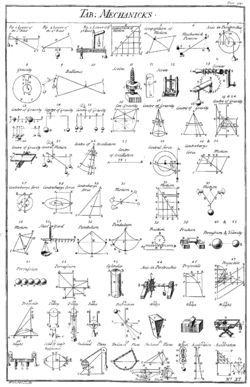Simple machine
From Wikipedia, the free encyclopedia
This article is about the concept in physics. For the Internet forum software, see Simple Machines Forum.

Table of simple mechanisms, from Chambers' Cyclopedia, 1728.[1] Simple machines provide a "vocabulary" for understanding more complex machines.
Usually the term refers to the six classical simple machines which were defined by Renaissance scientists:[4]
Simple machines are the elementary "building blocks" of which all more complicated machines (sometimes called "compound machines"[5]) are composed.[3][6] For example, wheels, levers, and pulleys are all used in the mechanism of a bicycle. The mechanical advantage of a compound machine is just the product of the mechanical advantages of the simple machines of which it is composed.
Simple machines fall into two classes; those dependent on the vector resolution of forces (inclined plane, wedge, screw) and those in which there is an equilibrium of torques (lever, pulley, wheel).
oleh husna
No comments:
Post a Comment